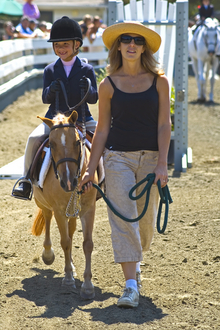The American Shetland Pony Club, Inc., one of the oldest breed registries in the United States, is not sitting on its laurels in 2012. Instead, this multi-faceted and multi-breed association is boldly expanding some of its offerings and upgrading other programs or division for a fresh new approach this year.

Shetland Pony Club involving youth
The American Shetland Pony Club is boldly expanding some of its offerings and upgrading other programs.
The American Shetland Pony Club, Inc., (ASPC) was established in 1888 to govern the then-burgeoning interest in Shetlands in the United States. ASPC is one of this country’s oldest equine governing bodies. In addition to championing and advancing the American Shetland, the ASPC established other breeds and divisions under its auspices that complement the association’s original vision and goals.
This summer, the ASPC will hold one of the oldest breed championships in this country when the National Shetland Congress celebrates its 65th anniversary. The 2012 National Shetland and Show Pony Congress will be held August 7-11 in Tulsa, OK.
In September, one of the ASPC Inc’s, most successful divisions – the American Miniature Horse Registry (AMHR) – will hold its 25th national championship show. The AMHR is the oldest Miniature Horse registry in existence, and its show is the largest small equine event in the world.
In 1971, the ASPC pioneered the first Miniature Horse registry in this country with the creation of the AMHR. In the 1980s, the club boldly enhanced this division’s long-term prospects when it expanded the height options and created a second division recognizing slightly larger, but still diminutive horses. To date, the AMHR has registered approximately 225,000 Miniatures. Watch for news on the 25th AMHR National Championship Show this fall. This year this competition is expected to draw between 1,600 and 2,000 Miniature Horses.
Establishing the AMHR is not the ASPC’s only success in expanding its versatility. In the 1980s, recognizing that some Shetland breeders were still enamored with the Shetland style and body-type prevalent in the mid-20th century, the ASPC established a “Classic” division. Today, Classic and Foundation American Shetlands are one of the ASPC’s strongest divisions.
Next, the ASPC set out to meet the needs of those who were raising show ponies by crossing registered Shetlands and Hackneys as well as to provide a venue for larger American Shetlands or smaller Hackneys to compete. The creation of the American Show Pony Registry in 1995 met all of these needs and continues to do so today.
2002 saw the creation of the National Show Pony Registry. The NSPR was geared to allow crossing of both ASPC Shetlands and AMHR Miniatures with other breeds, especially small horse breeds. This division was designed to offer a place for children to find ponies to ride within their “home” association after they outgrew riding Shetlands.
Currently, ASPC members are working to diversify and grow the NSPR. The group’s first step is to rename this division in 2012. The ASPC recently crossed the first hurdle in changing this registry’s name to the National Sports Performance Pony Registry (NSPPR). The NSPPR committee is also presently working to expand performance classes and options for this division. It also recently embarked on a small promotions campaign to begin to grow the NSPPR.
The ASPC/AMHR/ASPR youth program has been around many years. It embarked on an expansion in the mid-1990s that saw many new awards, educational opportunities and fun activities added for youth showing Shetlands and Miniatures. That growth has never stopped.
For 2012, ASPC’s Youth Program re-established and expanded one of its essay contests giving youth members across the country a chance to win their very own pony. In fact, the Chance of Love contest will give away three show-quality ponies this summer. This contest is currently ongoing. More information about it and all of the ASPC’s youth programs are available on the registry’s website or on the related youth website, http://www.aspcamhryouth.com.
